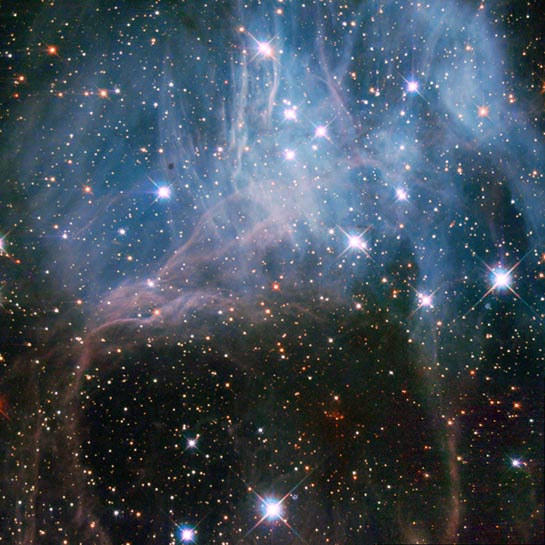
Star Cluster
RA 5h 36m 3.79s Dec -67° 34' 23.33"
Dorado
150,000 light years
3 x 3 arcmin
1.79 x 1.83 arcminutes
North is 30.0° right of vertical
ESA/Hubble, NASA & D. A Gouliermis. Ack: Eedresha Sturdivant
April 16, 2012
ABOUT THIS IMAGE:
These bright stars shining through what looks like a haze in the night sky are part of a young stellar grouping in one of the largest known star formation regions of the Large Magellanic Cloud (LMC), a dwarf satellite galaxy of the Milky Way. The image was captured by the NASA/ESA Hubble Space Telescope's Wide Field Planetary Camera 2.
The stellar grouping is known to stargazers as NGC 2040 or LH 88. It was discovered on September 27, 1826 by James Dunlop. It is essentially a very loose star cluster whose stars have a common origin and are drifting together through space. There are three different types of stellar associations defined by their stellar properties. NGC 2040 is an OB association, a grouping that usually contains 10-100 stars of type O and B - these are high-mass stars that have short but brilliant lives. It is thought that most of the stars in the Milky Way were born in OB associations.
There are several such groupings of stars in the LMC, including one previously featured as a Hubble Picture of the Week. Just like the others, LH 88 consists of several high-mass young stars in a large nebula of partially ionized hydrogen gas, and lies in what is known to be a supergiant shell of gas called LMC 4.
Over a period of several million years, thousands of stars may form in these supergiant shells, which are the largest interstellar structures in galaxies. The shells themselves are believed to have been created by strong stellar winds and clustered supernova explosions of massive stars that blow away surrounding dust and gas, and in turn trigger further episodes of star formation.
The LMC is the third closest galaxy to our Milky Way. It is located some 160,000 light-years away, and is about 100 times smaller than our own.
This
image, which shows ultraviolet, visible and infrared light, covers a field
of view of approximately 1.8 by 1.8 arcminutes.